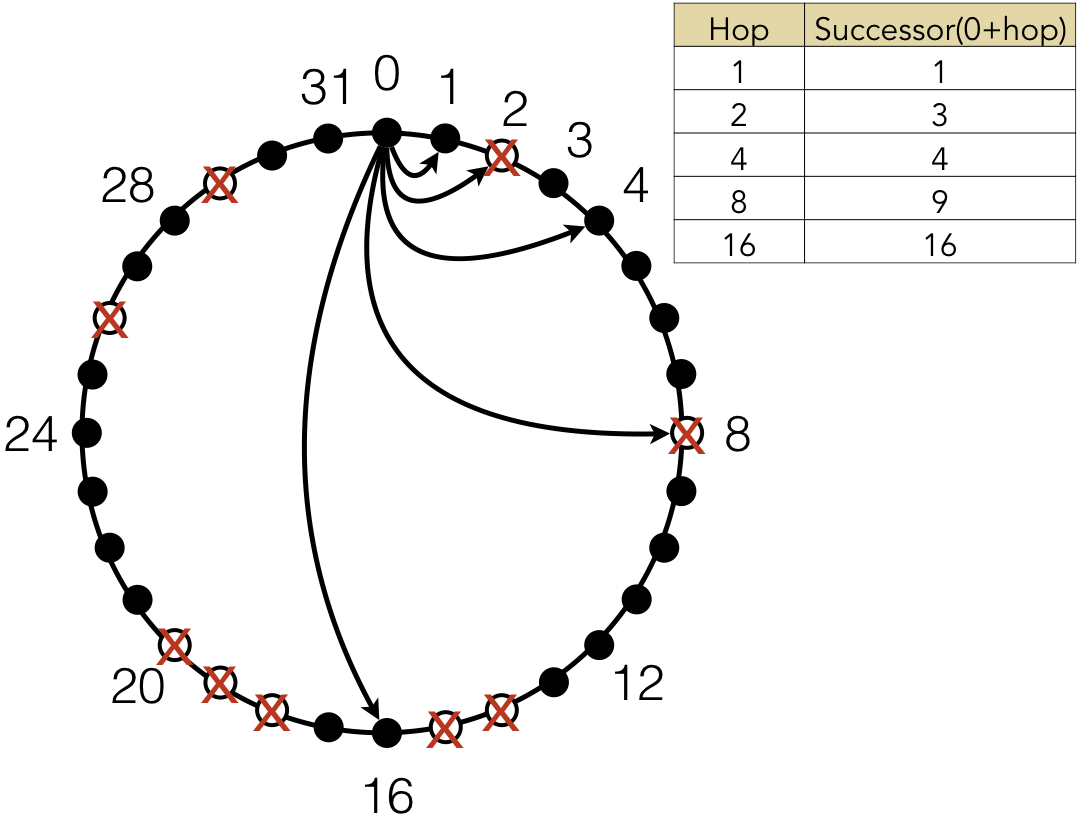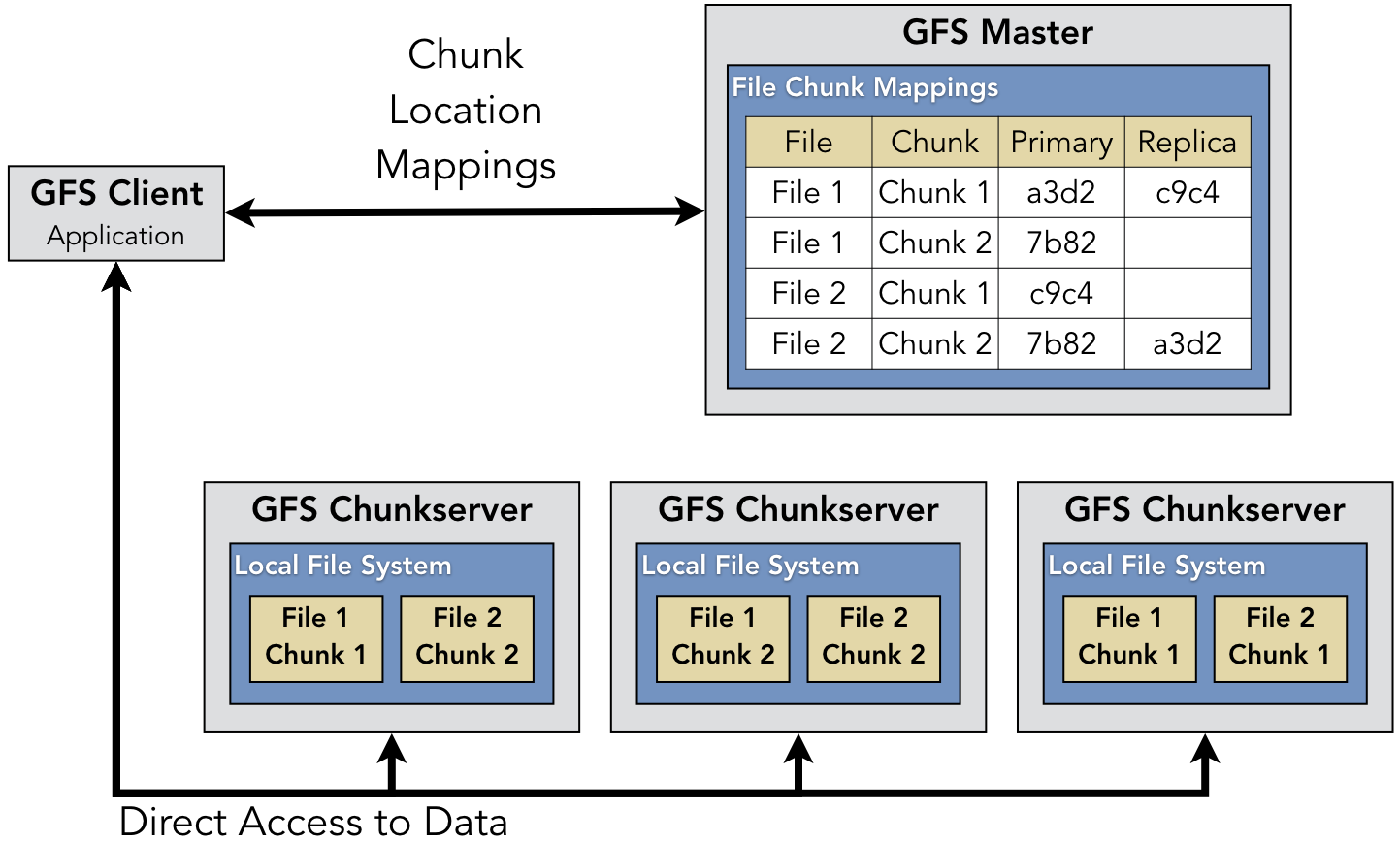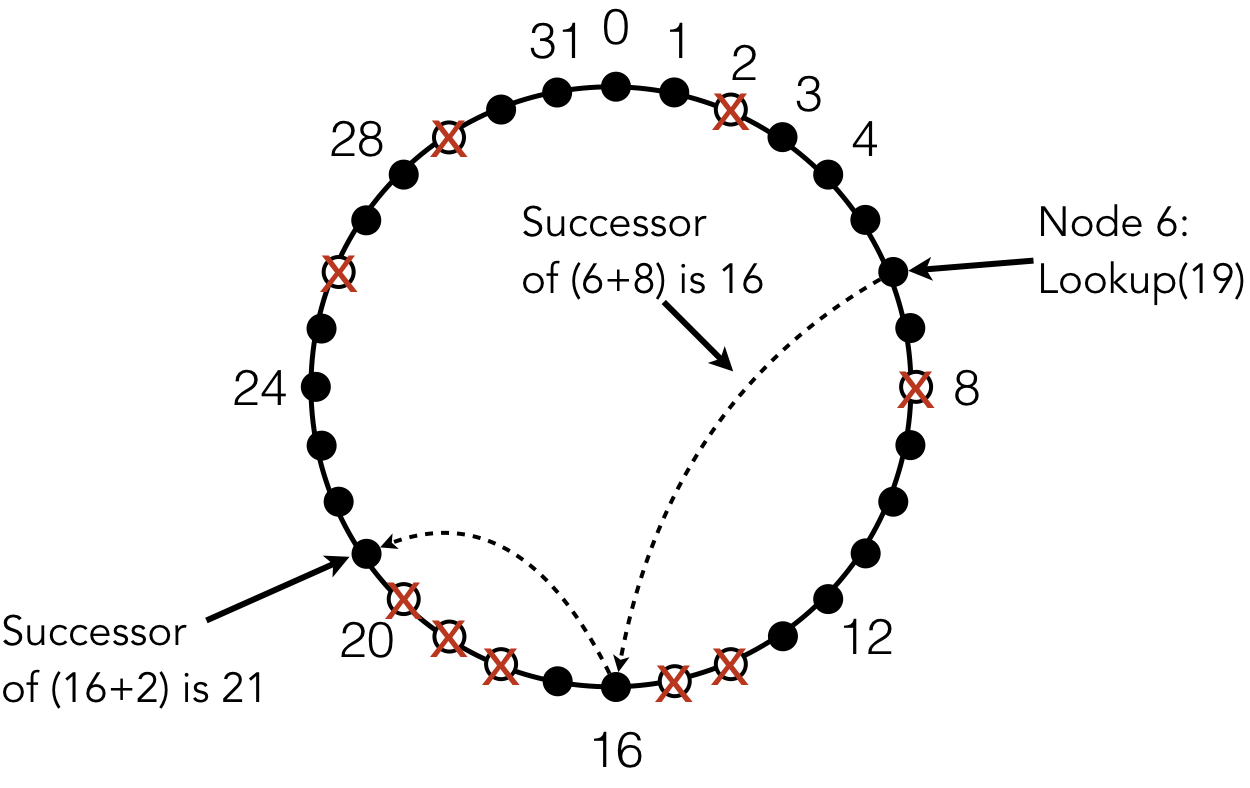9.6. Reliable Data Storage and Location¶
Distributed systems are commonly used to store collections of data.
Consequently, a key issue in distributed systems is knowing where to find the
data in question. As an example, consider a traditional static web page, such as
http://www.abc.com/index.html. The structure of this URL indicates that
there is a file named index.html located in the root directory of a web server.
Since the URL is an HTTP request, this web server is a process listening on port
80 from a machine somewhere. The hostname www.abc.com would be translated into
an IP address to determine the machine’s logical location within the Internet.
When the HTTP request gets made, the client sends the request to a router and
the request gets forwarded until it reaches this machine. In other words,
completing this single HTTP request requires identifying the machine that stores
the file, the logical location of the machine in the Internet, the physical
location of the network card that connects the machine, and the specific process
on that machine responsible for hosting that file. If any of those components
fail, then the file cannot be served to the user’s browser.
This scenario illustrates a common goal in distributed systems: how to locate and retrieve data objects reliably, even when components fail. The routing protocols of the Internet are designed around the assumption of failure. If a wire gets cut or a machine crashes, the routing protocols attempt to find an alternative path by updating their routing data structures. This design principle of reliable service with unreliable components can be extended to the application layer of the network stack, as well.
One fundamental building block of reliably locating objects in a distributed system is replication. When an object is replicated, multiple servers store identical copies, so clients can retrieve the object from several locations. Replication avoids the problem of a single point of failure — one node failure is not sufficient to eliminate all service. Additionally, replication provides a means of load balancing. Since the same object is accessible from multiple servers within the system, clients can request copies from any of them rather than overloading servers that host the most popular objects.
9.6.1. Google File System¶
As an example of how replication provides reliable service for data storage, consider the Google File System (GFS). Figure 9.6.1 shows the structure of the main components of GFS. In GFS, the assumption is that files are large (e.g., each file might be multiple terabytes in size), so they are broken up into chunks. The individual chunks with the file contents are stored on chunkservers. Each of these chunkservers contains its own traditional local file system; for example, assuming the machines are running Linux, then the chunks would be stored as local files within that chunkserver’s ext4 file system. In addition, a GFS master maintains a non-authoritative table that maps files to their locations.
For each given chunk, there is a designated primary chunkserver along with
multiple replicas. The primary and replicas all store identical copies
of the chunks, but the primary is designated as having a lease on the file and
has exclusive access to modify it if needed. For instance, in Figure 9.6.1,
the first chunk of File 1 can be retrieved from either node
a3d2 (the left-most chunkserver) or node c9c4 (the right-most).
Ultimately, each chunkserver has full control over the chunks that it stores,
and this information might differ from the records in the GFS master. To keep
the GFS master’s records updated, the GFS master sends out periodic HeartBeat
messages to the chunkservers to determine their current status and provide
additional instructions.
9.6.2. Distributed Hash Tables¶
GFS was designed to create a distributed file system for a single organization.
Consequently, Google could build in some assumptions into the design about the
locations of nodes. When the GFS master in Figure 9.6.1
informed the client that node a3d2 was the assigned primary for chunk 1 of
file 1, the client knew which machine to contact, because the clients maintain
information about the IP addresses of nodes in the system. In other distributed
file systems—particularly those designed to be openly accessible—clients do not
have this information.

Figure 9.6.2: A Chord ring with up to 32 nodes. Black nodes are live (available); nodes with a red X are considered failed (absent or unavailable)
Instead of relying on the clients to have information about node locations, systems can create a distributed hash table (DHT) that maps objects to machines that host them. Chord was an early [1] and influential DHT. In Chord, all nodes were assigned unique identifiers and arranged in a logical ring structure. Figure 9.6.2 shows the logical structure of a simplified Chord ring with support for 32 nodes. (Chord node identifiers are created by calculating the hash of the machine’s IP address; for a 256-bit hash value, the ring would have up to $2^{256}$ nodes.) Most of the nodes are live, meaning those machines are running and connected to the system; nodes marked with an X (e.g., 2, 8, and 14) are not connected.
Figure 9.6.2 also shows a key data structure to define the nature of the Chord ring: the finger table. Every node contains a finger table, which contains information about other Chord ring indexes. Each entry in the finger table is based on the current node’s identifier plus a power of 2. The finger table shown here would be the table for node 0. Node 0 would contain information about the indexes 1, 2, 4, 8, and 16 (i.e., $0+2^0$, $0+2^1$, $0+2^2$, $0+2^3$, and $0+2^4$). Similarly, node 1 would contain information about 2, 3, 5, 9, and 17 ($1+2^0$, $1+2^1$, $1+2^2$, $1+2^3$, and $1+2^4$). However, given that some nodes are missing (such as 2 and 8), Chord nodes keep track of the successor of the target index, which is the closest value greater than or equal to the index. Since 1, 4, and 16 are present, these nodes are their own successors. Since 2 and 8 are missing, 3 is the successor of 2 and 9 is the successor of 8. Within the finger table, the Chord nodes keep track of information about that successor, including its IP address.
The logical ring structure of Chord makes it possible for items to be located
very efficiently, even though nodes in the system have very little information
about the structure. Assume that a user is running a client on node 6. This user
tries to open the file "chord/data/foo". As with the node identifiers,
objects are mapped to keys using hashes, so the user would calculate the hash of
the file name. If "chord/data/foo" hashes to the value 19, then the
successor of 19 is deemed the location of that object.
Figure 9.6.3 shows the routing of the request message through the Chord ring. Node 6 would have entries for the successors of 14 ($6+2^3$) and 22 ($6+2^4$). Since 22 is greater than the target key 19, node 16 would try to contact the successor of 14. Since node 14 is absent from the ring, node 6 would actually contact node 16. Note that node 6 determines this itself, because this information is stored in its own finger table. When node 16 receives the request for key 19, it would find the successor of 18, which is $16+2^1$. Since nodes 18, 19, and 20 are all missing, node 21 is the successor of 18, so this node is the location of the requested file.
The routing structure of Chord is deceptively powerful. Although it seems complicated, the structure is straightforward to implement in code. Code Listing 9.10 illustrates the algorithm for this lookup procedure. The logic of the algorithm is to start with the last entry of the finger table (assuming 64 entries because of 64-bit integer types; supporting a 256-bit identifier would require larger integer types) and work backwards to find the first entry that precedes the key.
1 2 3 4 5 6 7 8 9 10 11 12 13 14 15 16 17 18 19 20 | /* Code Listing 9.10:
Algorithm for finding the next node in a Chord finger table
*/
#define NUM_ENTRIES 63 /* assume all keys are 64 bits */
uint64_t
lookup (uint64_t key)
{
for (int index = NUM_ENTRIES; index > 0; index--)
{
if (node_id < finger_table[index])
{
if (key >= finger_table [index] || key < node_id)
return finger_table [index];
}
else if (key >= finger_table [index] && key < node_id)
return finger_table [index];
}
return node_id; /* default response is current node */
}
|
The logic in Code Listing 9.10 is complicated by the modular
arithmetic imposed by the Chord ring structure. Essentially, the algorithm
starts by looking at node_id + 2max and incrementally
decreases the exponent. Each time, the algorithm checks that the key would occur
after the jumped node but before the current node. For instance, considering
the lookup in Figure 9.6.2, the algorithm would look at
$6+^2$4, to check if the key lies after 22 but before 6; if so, the algorithm
would return 22 as the next node to jump to, otherwise it would look at $6+2^3$.
If we consider a similar query, though, starting from node 18, the algorithm
would first look at $18+2^4$, but this value must be mapped to the ring by
applying mod 32. As such, the algorithm would need to check if the key comes
after node 2 and before node 18. With modular arithmetic, determining whether a
key value is between two nodes on the ring can be tricky to get the logic correct.
The benefit of the Chord structure is that it places a very efficient upper-bound of Θ(log n) on the number of messages to find an object in the system. To put that into practical figures, given a system with 1,000,000 nodes storing data, any item could be found by forwarding the request at most 20 times. If the number of nodes doubles, the maximum number of request messages would only increase by one. Consequently, the network overhead with Chord is very light.
To improve the system performance further, Chord also employs replication
through caching. Whenever a node is involved in looking up an object’s location,
that node receives a copy of the object, as well. Returning to Figure 9.6.2,
since node 16 was used as a step toward locating key 19 at
node 21, node 16 also gets a copy. At that point, any request for the file
"chord/data/foo" that goes through either node 6 or 16 will get a faster
response. Since these nodes have a local replica of the file, there is no need
to forward the request. Because of this caching technique and other forms of
replication, Chord provides efficient times to find objects and high levels of
availability (even when nodes fail).
| [1] | During the 2001-2003 time frame, several DHTs were designed and proposed. Chord, along with Pastry, Tapestry, and CAN, was one of the four original systems created at this time. All of these systems contributed important ideas to this subfield of distributed systems. |

